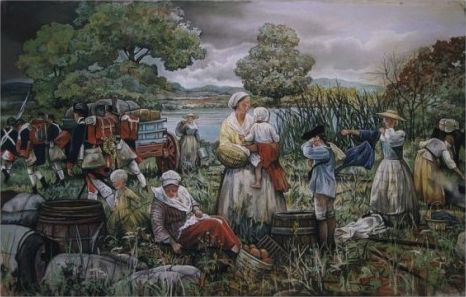Discussions about fertility and flag making couldn’t seem more incompatible at first glance. During the American Revolution, however, both spoke multitudes about the place women had in society, the roles they were expected to play. Susan Klepp and Laurel Ulrich, in writing about the revolutionary fertility transition and the legend of Betsy Ross, respectively, tapped into a shared, often forgotten history about women and the contributions they made to the changing culture apparent in the burgeoning nation during the late 18th and early 19th centuries. Both “Revolutionary Bodies” and “How Betsy Ross Became Famous” address how women, through their ideals and roles, helped create a new nation and its cultural atmosphere.
Although most of Klepp’s article revolves around the ways in which the view of women’s bodies shifted, specifically in childbearing, it’s important to note that at this point in history a great deal of conversations about women only centered on this aspect of them. Women still made up half of the population – any shift, especially as large as the one detailed in “Revolutionary Bodies,” would naturally lead to a shift in the overall culture and society.1 Revolutionary rhetoric around freedom, liberty, or the pursuit of happiness helped confront, establish, or emphasis gender norms in American society. Klepp argues that this rhetoric helped caused a move in thinking around fertility, these further emphasizing personal autonomy not just in women but in all of the populace.2 Personal autonomy allowed women to participate in Revolution, by creating invaluable women’s camps that followed the main army around, providing laundry or nursing services, or by participating in boycotts via non consumption and nonimportation.3
 4
4
This participation is where Betsy Ross, or the legend of Betsy Ross, fits into the picture. The story of Betsy Ross is almost inseparable with other stories about the American Revolution, and it’s worth mentioning that the role of this creator of the most ubiquitous symbol of America would be a woman. She personifies this era in American history where women were becoming autonomous and becoming more outspoken but still embodied an idea of domesticity and even fertility, as evidenced in some art and language surrounding the creation of the flag.5 Betsy Ross was not a leader, or a politician, or involved in any military matters but she still factors very heavily into our national story and identity. Although most of her story only made it into the public consciousness during the 19th century, her image fits into the place women held during the Revolution and contributes to this shift in thinking.
It is impossible to discuss this topic, women during the Revolution, however, without discussing the simple fact that makes some of this conjecture – women’s voices were not as loud in the past as they are today, for various reasons.6 Not only that, but much of the history we gleam about women in this period, most notably Betsy Ross, is only passed down through oral tradition, a tricky source that often doesn’t allow for physical evidence. According to Ulrich, “To use such materials requires much sifting, much sorting, and more sophisticated analysis than most scholars have yet undertaken.”7 Because of this uncertainty, it is hard to imagine women’s own attitudes toward these changing ideals or confirm if certain modern theories and models are true. In the case of Betsy Ross, it is hard to be sure if she ever did the things she did – although because, as Ulrich notes, her story would likely be typical of many women during the Revolution, and as such her role in the conflict and movement in her legend can still inform us of the role of women in general at the time.8 Despite the limitations, however, the changing role of women can be seen throughout this period in history, and the role they played in war, revolution, and domestic life is one that was and is still invaluable.
Footnotes
- Susan E. Klepp, “Revolutionary Bodies: Women and the Fertility Transition in the Mid-Atlantic Region, 1760 – 1820,” The Journal of American History 85, no. 3 (Dec., 1998): 914.
- Susan E. Klepp, “Revolutionary Bodies: Women and the Fertility Transition in the Mid-Atlantic Region, 1760 – 1820,” The Journal of American History 85, no. 3 (Dec., 1998): 912.
- Susan E. Klepp, “Revolutionary Bodies: Women and the Fertility Transition in the Mid-Atlantic Region, 1760 – 1820,” The Journal of American History 85, no. 3 (Dec., 1998): 930.
- Pamela Patrick White, “Following the Army” http://www.revwar75.com/library/rees/wnumb1.htm
- Laurel Thatcher Ulrich, “How Betsy Ross Became Famous,” Common-Place 8, no. 1 (Oct., 2007): 12, accessed January 30, 2018, http://www.common-place-archives.org/vol-08/no-01/ulrich/
- Susan E. Klepp, “Revolutionary Bodies: Women and the Fertility Transition in the Mid-Atlantic Region, 1760 – 1820,” The Journal of American History 85, no. 3 (Dec., 1998): 916.
- Laurel Thatcher Ulrich, “How Betsy Ross Became Famous,” Common-Place 8, no. 1 (Oct., 2007): 9, accessed January 30, 2018, http://www.common-place-archives.org/vol-08/no-01/ulrich/
8. Laurel Thatcher Ulrich, “How Betsy Ross Became Famous,” Common-Place 8, no. 1 (Oct., 2007): 3, accessed January 30, 2018, http://www.common-place-archives.org/vol-08/no-01/ulrich/
